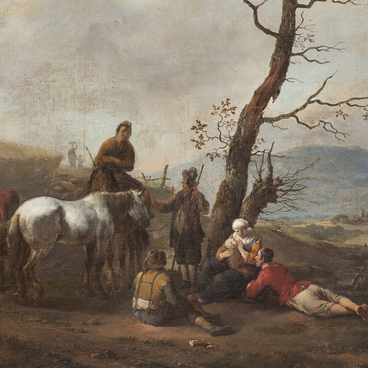Dutch painter and graphic artist Barend Cornelis Koekkoek is considered to be the founder of the Dutch romantic landscape. He was born in a family of a self-taught artist, marine painter Jan Herman Koekkoek, whose landscape is also kept in the collection of the Radishchev Museum. It was his father who became his first teacher. Then he continued his education in the Royal Academy of Fine Arts in Amsterdam. As early as in his youth the landscapes by Barend Koekkoek were wide popularity.
This artist creating in the traditions of the old Dutch painting is recognized as one of the best Dutch landscapers of the 19th century. He deserved a title ‘prince of artists’ in the Netherlands. However, the desert landscapes of Dutch rural areas couldn’t satisfy the romantic soul of the artist. In 1841 he wrote: “Our homeland cannot boast of rocks, waterfalls, high mountains or romantic valleys. One should not look for lordly sublime nature in our country”. In his search of romantics, in summer 1834 he relocated to Cleve, an old capital of Duchy in Germany, where he found his ideal of nature in the valleys of Rhine and Ruhr.
Here he spent the rest of his life and painted his best landscapes. Soon big oak-trees, curving paths and panoramic views from extensive river valleys to idyllist views of forests filled his canvases.
The scrupulous drawing of the tiny details and conveyance of the state of atmosphere perfectly blended in them. As other romantic artists, Koekkoek painted miniature figures against the background of grandiose nature, thus matching the pettiness of a human being against the grandeur of Creation. The forest was a favorite theme of the artist. In 1841 Koekkoek founded the Arts school in Cleve. Now this building built in the style of Dutch romanticism is the Arts museum and one of the most beautiful architectural monuments of the mid 19th century in Rhine region of Germany and the regions of the Netherlands adjacent to it.
Barend Cornelis obtained endless prizes and honorary distinctions and among his customers was the Prussian King Friedrich Wilhelm IV, King of the Netherlands Willem II and the Russian Emperor Alexander II.
In 1832 Koekkoek became a member of the Royal Academy of Arts in Amsterdam, in 1856 — an honorable member of the Belgium Community of watercolorists in Brussels. He was well known in Russia; in 1861 he became an honorable member of the Academy of Arts in Saint Petersburg. The painting was gifted to the Radishchev Saratov State Museum in 1886 by Sergey Mikhailovich Tretyakov, brother of Pavel Mikhailovich Tretyakov, founder of the Tretyakov Gallery, who collected, as distinct to him, the Western European paintings.



